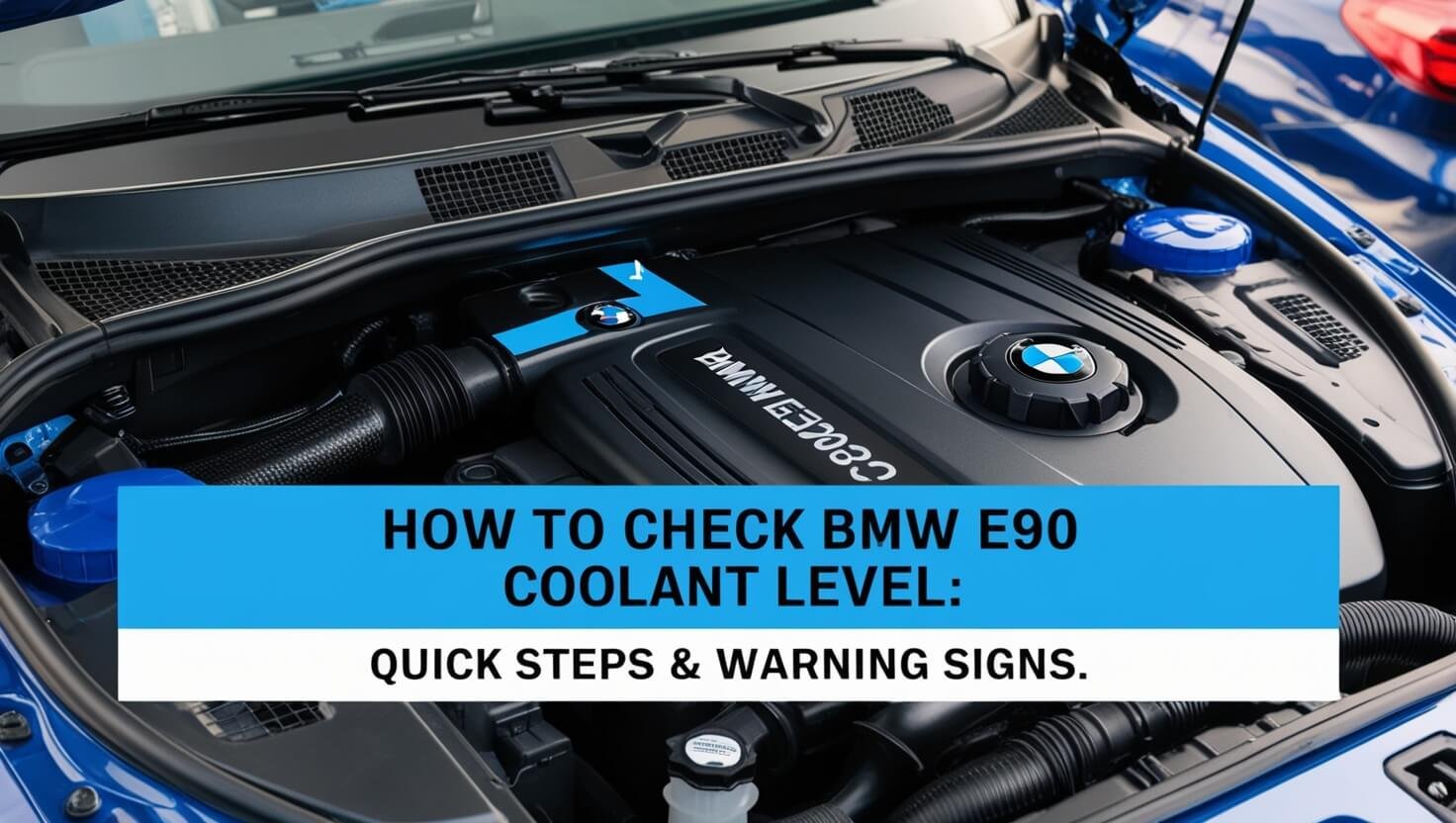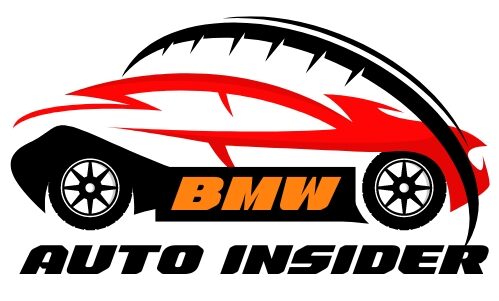
Keeping the right coolant level in your BMW E90 is key for good engine performance and avoiding expensive repairs. The BMW E90 has a special coolant system with an expansion tank. It’s different from older systems. Checking the coolant level often is vital for your car’s health.
The expansion tank for the BMW E90’s coolant system is on the front passenger side of the engine bay. Always check the coolant level when the engine is cold. This way, you get an accurate reading and avoid burns from hot coolant. The coolant level should match the lip of the expansion tank when the engine is cold.
When you need to refill the coolant, use only BMW-approved coolants. The most common one is PN: 82141467704. Avoid using coolants not made by BMW as they can harm your cooling system. BMW suggests mixing the coolant with water at a 50/50 ratio before adding it to the system.
BMW E90 Coolant System Components
The BMW E90 coolant system is key to keeping the engine running smoothly and preventing overheating. At its core is the coolant expansion tank. This black, non-transparent part is crucial for keeping the coolant at the right level.
Expansion Tank Location and Design
The coolant expansion tank is placed in the engine bay, on the driver’s side. It has a red float indicator to show the coolant level. The tank’s design lets the coolant expand and contract with engine temperature changes. This ensures a steady coolant supply.
Coolant Level Sensor Function
The coolant level sensor is at the bottom of the expansion tank. It watches the fluid level and talks to the car’s computer. If the coolant level gets too low, a warning light on the dashboard will turn on. Paying attention to this warning can save your engine from damage.
Types of BMW-Approved Coolants
BMW has made special coolants for their cars. These coolants protect against corrosion, boiling, and freezing. They keep your bmw e90 coolant reservoir and cooling system in good shape. Always use the right coolant to avoid bmw coolant leak diagnosis problems.
Safety Precautions Before Checking Coolant
Checking the coolant level in your BMW E90 is key to keeping it running well. But, before you start, it’s vital to take safety steps. This protects you and helps you do the job right.
First, make sure the engine is cold. Hot coolant can burn you badly. So, let the car cool down for hours after driving.
When you open the expansion tank cap, do it slowly. This lets pressure out safely, avoiding hot coolant sprays.
- Always wear protective gloves and eyewear when handling coolant to avoid skin and eye irritation.
- Ensure the work area is well-ventilated, as coolant can release fumes that should not be inhaled.
Taking these simple steps, you can stay safe while checking the bmw e90 overheating prevention. Your safety is important. It makes the job easier and safer.
How To Check BMW E90 Coolant Level
Keeping the right coolant level in your BMW E90 is key for good engine performance. It also helps avoid expensive repairs. To check the coolant level, first find the expansion tank on the front passenger side of your car.
Cold Engine Inspection Process
Start by removing the expansion tank cap when your engine is cold. Turn it counterclockwise. Then, use your finger to gently push down the red float and watch it bob back up. The coolant level is right when the float is even with the tank’s lip.
Reading the Float Indicator
If the float stick in your expansion tank is missing, you’ll have to look at the coolant level yourself. Some people have found that 1 out of 5 have a broken coolant level stick. This might mean there’s a problem with the cooling system’s plastic parts.
Proper Coolant Level Markers
- The coolant level should reach the top of the expansion tank opening, not protrude excessively.
- Users recommend tapping the expansion tank to resolve the issue of a missing or broken coolant level stick.
- If the float in the expansion tank is broken, it’s likely that the rest of the tank will break soon, costing around $58 to replace.
Remember, a broken coolant level stick can mess with the coolant level sensor and warning system. So, it’s important to fix any problems quickly. By following these steps, you can keep your BMW E90’s coolant level right and avoid engine issues.
Common Coolant Level Warning Signs
Keeping the right coolant level in your BMW E90 is key for its cooling system’s health. Dashboard warning lights alert you to issues, but knowing common signs helps prevent problems.
The low coolant warning light on your dashboard is a clear sign. It can mean low coolant or a faulty sensor. If this light keeps coming on, it might point to a bigger issue like a leak or a cooling system problem.
A sweet, syrupy smell from the engine bay is another warning. This smell often means coolant is leaking. You’ll also see leaks around the radiator, hoses, or other parts if your cooling system needs fixing.
Don’t ignore an overheating engine. If your temperature gauge goes up or the engine gets too hot, pull over. Let it cool down. Ignoring this can cause serious damage.
Being quick to spot and fix coolant issues helps avoid expensive repairs. It also keeps your BMW E90’s cooling system running well. If you’re unsure, a BMW expert can check and fix any problems.
BMW E90 Coolant Reservoir Inspection
Keeping the coolant reservoir in good shape is key for the BMW E90’s cooling system. Regular checks can spot problems early, preventing bigger issues.
Visual Inspection Points
Begin by looking closely at the coolant reservoir for damage or wear. Check for cracks, color changes, or shape issues. Make sure the cap seal is tight and not worn out. Also, examine the hoses for damage or leaks.
Checking for Cracks and Damage
Cracks or damage in the bmw e90 coolant reservoir is common. Inspect the whole reservoir for any small or big cracks. If you find damage, get a BMW expert to replace it to avoid bigger problems.
Also, watch for coolant spills or color changes around the reservoir. These signs mean there’s a leak that needs fixing fast. Fixing these issues quickly can prevent engine overheating and costly repairs later.
Proper Coolant Filling Techniques
Refilling coolant in your BMW 3 Series (E90) needs careful steps. It’s important to use only BMW-approved coolant. This prevents damage to your car’s cooling parts.
Begin by slowly pouring coolant into the expansion tank. Be careful not to fill it too much. The coolant level should just reach the top of the tank. If you fill too much, use a turkey baster or the radiator bleed screw to remove excess.
| BMW E90 Model | Coolant Capacity |
|---|---|
| Automatic Transmission | 8.2 Liters |
| Manual Transmission | 8.4 Liters |
Some BMW E90 models have two radiator drain plugs. You’ll find one on each side. Always check both when draining or filling the system.
Air pockets can form when adding coolant. It’s key to bleed the cooling system each time you service it. The electric coolant pump will run for about 12 minutes to get rid of air pockets.
Following these steps, you keep your BMW 3 Series (E90)’s cooling system right. This prevents overheating and helps your engine last longer.
Coolant System Bleeding Procedures
It’s important to bleed the BMW E90 coolant system right. This ensures heat is transferred well and avoids problems. You need to get rid of air pockets in the system for coolant to flow smoothly.
Air Pocket Removal Steps
To remove air pockets, follow these steps:
- Find the bleeding screw at the radiator’s bottom. It’s a small, hex-shaped screw.
- Slowly turn the bleeding screw open. Let the coolant flow out until no air bubbles are seen.
- After the flow is clear, close the screw tightly.
- Check the coolant level in the expansion tank. Add more if needed.
- If you find more air pockets, repeat the process.
Bleeding Screw Locations
The bleeding screw is usually at the radiator’s bottom. But, some models might have more screws or points, like:
- On the engine block or cylinder head
- In the coolant lines to the heater core
- Near the water pump or thermostat housing
Check your BMW’s service manual or ask a trusted technician. They can tell you where the bleeding screws are for your car. This ensures all air is removed.
Bleeding the coolant system right is key for your BMW E90’s performance and life. By following these steps, you help keep your car’s cooling system working well. This makes for a better driving experience.
Coolant Leak Detection Methods
Finding a coolant leak in your BMW E90 is key to keeping your car’s cooling system working right. There are many ways to spot coolant leaks, each with its own benefits.
Visual Inspection
First, check your BMW E90’s engine bay carefully. Look for coolant leaks, like dried spots or stains on parts. Focus on hoses, the radiator, and the water pump, as these spots leaks often.
Pressure Testing
For leaks that are tough to find, try a cooling system pressure tester. It lets you pressurize the system to spot small leaks you can’t see. This method is better than just looking because it’s more accurate and saves time.
UV Dye Tracing
- Using UV dye is another good way to find leaks. Just add some UV dye to the coolant, then shine a UV light to see where it goes. This shows you where the leak is.
- This method is great for finding leaks that are hard to see, like inside the engine or hidden behind parts.
Using these different ways to find leaks, you can quickly find and fix any coolant loss in your BMW E90. This keeps your car’s cooling system running well.
| Leak Detection Method | Advantages | Disadvantages |
|---|---|---|
| Visual Inspection | Simple and inexpensive Can detect obvious leaks | May miss small or hidden leaks Time-consuming to thoroughly inspect the entire system |
| Pressure Testing | Can detect small, hard-to-see leaks Saves time compared to visual inspection Provides more accurate results | Requires specialized equipment May not detect internal leaks (e.g., head gasket) |
| UV Dye Tracing | Can detect internal and external leaks Helps identify the exact source of the leak | Requires the addition of a UV dye to the coolant Requires a UV light for inspection |
Expansion Tank Maintenance Tips
Keeping the BMW E90’s coolant expansion tank in good shape is key. It helps the cooling system work right. Regular checks and early actions can stop expensive fixes later.
Regular Inspection Schedule
Check the expansion tank every time you change the oil in your BMW E90. Look for signs of wear, like small cracks or rotting. If you see coolant leaks, fix them fast to avoid losing a lot of coolant.
Preventive Measures
Replace the expansion tank when you’re fixing other cooling system parts, like the water pump or thermostat. This keeps the tank in great shape and lowers the chance of it failing. Use top-notch parts from Pelican Parts for the best results. You can reach them at 310-626-8765, Monday to Friday, 7 am to 5 pm (PST), or visit them at 1600 240th Street, Harbor City, CA 90710.r. Using the correct coolant and following the manufacturer’s advice is crucial for your BMW E90’s cooling system to work right and last long.





